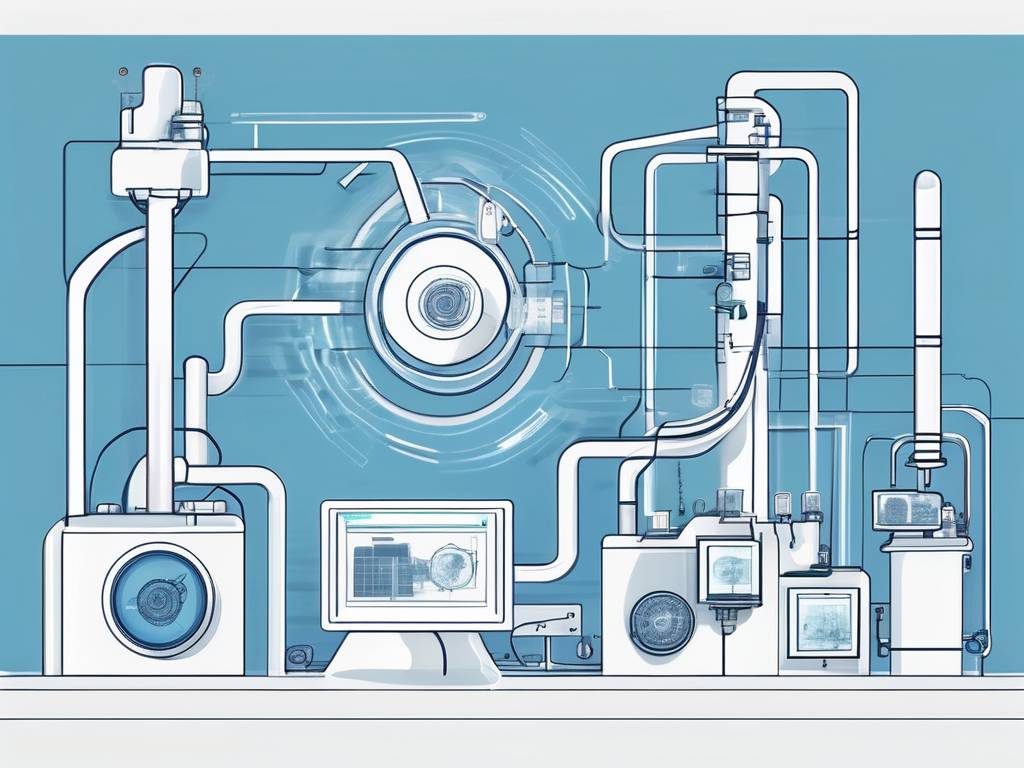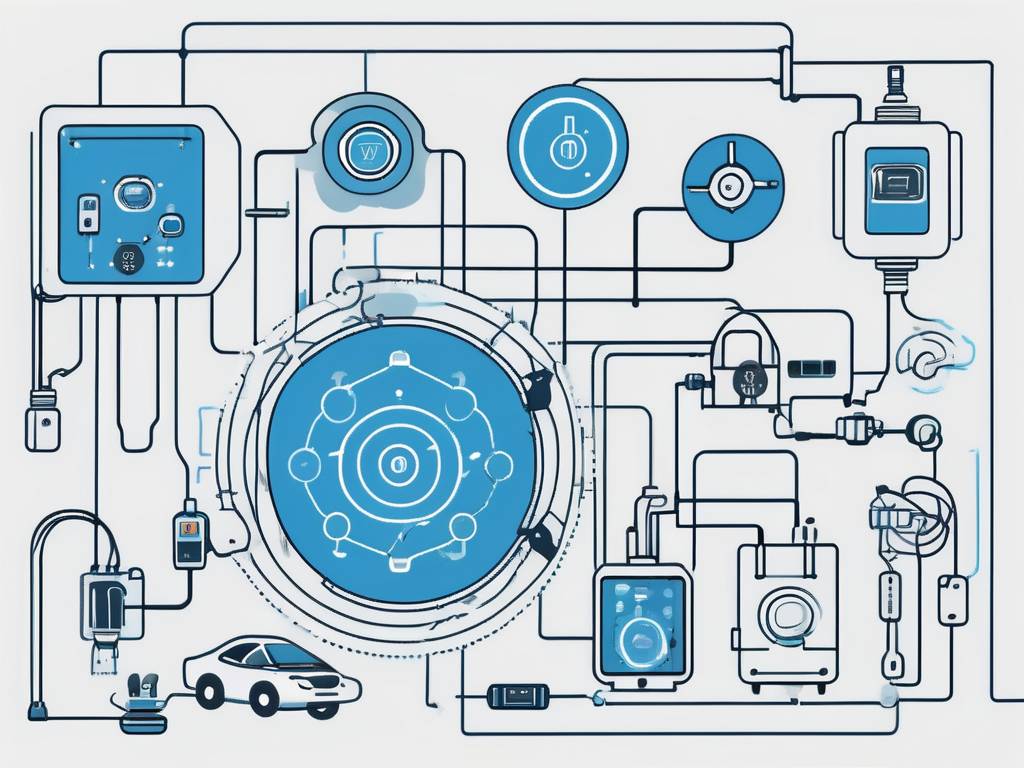IoT Home Automation: Internet of Things Explained
The Internet of Things (IoT) is a revolutionary concept that has transformed the way we live, work, and play. The term refers to a network of physical devices, vehicles, appliances, and other items embedded with sensors, software, and network connectivity, which enables these objects to connect and exchange data. One of the most exciting applications of IoT is in the realm of home automation, where it has the potential to make our lives more comfortable, convenient, and secure.
Home automation, also known as domotics, is a field within building automation that specializes in the specific automation requirements of private homes. It involves the control and automation of lighting systems, heating, ventilation, air conditioning (HVAC), and security systems, as well as home appliances such as washer/dryers, ovens, or refrigerators/freezers. IoT has significantly expanded the possibilities of home automation systems, allowing us to control these systems remotely and even anticipate our needs.
Understanding IoT
The Internet of Things is a broad and complex concept that encompasses many different technologies, standards, and applications. At its core, IoT is about connecting physical objects to the internet, enabling them to send and receive data. This is achieved through the use of IoT sensors and actuators embedded in the objects, which can detect changes in their environment and respond accordingly.
These sensors and actuators are connected to a central hub or gateway, which collects and processes the data they produce. This hub can be a physical device, such as a home router, or a virtual platform hosted in the cloud. The hub has a user interface that allows users to monitor and control their internet connected devices remotely from mobile devices.
The Role of Sensors & Actuators
Sensors play a crucial role in IoT devices by providing the data that drives the system. They can measure a wide range of physical properties, such as temperature, humidity, light intensity, motion, and more. For example, a temperature sensor in a smart thermostat can detect when the temperature in a room falls below a certain level and can send a signal to the heating system to turn back on.
Actuators, on the other hand, are devices that perform a physical action in response to a command. In the example above, the heating system would be the actuator, as it responds to the command from the thermostat. Actuators can also be things like light switches, door locks, and even robotic arms.
Communication Protocols
Communication is a vital aspect of IoT, and there are many different protocols that can be used for this purpose. These protocols define how data is transmitted and received between devices, and they can be broadly divided into two categories: wired and wireless.
Wired protocols, such as Ethernet and USB, are generally faster and more reliable than wireless protocols, but they require physical connections between devices. Wireless protocols, such as Wi-Fi, Bluetooth, and Zigbee, are more flexible and easier to install, but they can be affected by interference and have a limited range.
IoT Home Automation
Home automation is one of the most popular applications of IoT, and it’s easy to see why. By connecting smart home appliances and systems to the internet, we can control them remotely, monitor their status, and even automate their operation based on predefined rules or patterns of behavior.
For example, a smart thermostat can learn your schedule and adjust the temperature in your home accordingly, saving energy and bringing your home to a comfortable temperature before you arrive. Similarly, a smart security camera system can notify you if it detects unusual activity, allowing you to monitor your home from anywhere in the world.
Smart Appliances
Smart appliances are a key component of home automation. These are regular household appliances, such as refrigerators, ovens, and washing machines, that have been equipped with sensors, actuators, and network connectivity. This allows them to operate more efficiently, provide additional features, and integrate with other devices in a home.
For example, a smart refrigerator can monitor its contents and notify you when you’re running low on certain items. It can also suggest recipes based on what you have in stock, and even order groceries online. A smart washing machine, on the other hand, can detect the type and amount of laundry in a load and adjust its cycle accordingly, saving water and energy.
Another example of smart appliances are smart mirrors, which conveniently display a variety of information on their surface, including the time, weather, news, and personal schedules. This functionality allows you to effortlessly stay informed while preparing for your day, streamlining your morning and evening routines.
Smart Home Technology
Smart home systems are platforms that integrate various smart home assistant devices and allow them to work together. Smart home systems usually consist of a central hub, which connects to the internet and communicates with the devices, and a user interface, which allows you to control and monitor the system.
There are many different smart home systems available, ranging from simple DIY solutions to sophisticated professional installations. Some of the most popular examples of smart home technology include Amazon’s Alexa, Google’s Home, and Apple’s HomeKit. These systems support a wide range of devices and offer various features, such as voice commands, automation, and integration with third-party services.
Advantages of IoT Home Automation
IoT home automation offers many benefits, both practical and aesthetic. On the practical side, it can make our homes more comfortable, convenient, and secure. For example, a smart thermostat can ensure that your home is always at the perfect temperature, while smart locks and a smart security system can keep you safe from intruders.
On the aesthetic side, home automation can help you create the perfect ambiance in your home. For example, smart lighting can adjust the intensity and color of lights in a home based on the time of day, your mood, or the activity you’re doing. Similarly, a smart sound system can play the right music in each room, creating a seamless audio experience throughout your home.
Energy Efficiency
One of the main advantages of home automation is energy efficiency. By optimizing the operation of our appliances and systems, we can significantly reduce our energy consumption and lower utility bills. For example, a smart thermostat can adjust the temperature in your home based on your schedule, ensuring that you’re not wasting energy heating or cooling your home when you’re not there.
Similarly, smart lighting can turn off the lights when no one is in the room, and a smart power strip can cut off standby power to your devices when they’re not in use. Some systems can even monitor your energy usage and provide you with detailed reports, helping you identify areas of improvement.
Convenience
Another major advantage of home automation is convenience. With a smart home system, you can control all your devices from a single interface, whether it’s a smartphone app, a web portal, or a voice assistant. This means you no longer have to walk around the house to turn off the lights, adjust the thermostat, or check if the doors are locked. You can do all these things and more from the comfort of your couch, or even from outside your home.
Home automation can also automate many of the tasks that we do on a daily basis. For example, you can set your coffee maker to start brewing at a certain time, so you can wake up to the smell of fresh coffee. You can also program your blinds to open and close with the sun, so you can make the most of natural light. You can even set your robot vacuum to clean the house while you’re at work, so you can come home to a clean house every day.
Challenges & Concerns With Smart Home Automation
Despite its many benefits, IoT home automation also presents several challenges and concerns. These include technical issues, such as compatibility and interoperability, as well as broader issues, such as privacy and security.
IoT Compatibility & Interoperability
The Internet of Things faces significant challenges due to the lack of universal standards for compatibility and interoperability. This issue stems from the diverse landscape of IoT, where numerous manufacturers produce devices with different technologies, protocols, and security levels. Such variability not only hampers seamless device integration but also introduces significant security vulnerabilities, as each device could potentially become a weak link in the network.
Achieving interoperability among these devices is complicated by their varied designs and functions, making it difficult to ensure cohesive operation within larger systems. Moreover, the absence of a standardized security framework leaves the IoT ecosystem exposed to threats, compromising data confidentiality, integrity, and availability.
To overcome these challenges, industry-wide collaboration is crucial to develop and adopt comprehensive standards that ensure devices can communicate effectively while maintaining stringent security measures. Establishing such standards is essential for the IoT’s advancement and the reliability of its interconnected systems, ensuring a secure and efficient digital environment.
Privacy & Security
Privacy and security are major concerns in IoT home automation. Since these systems collect and transmit a lot of personal data, they can be a target for hackers and other malicious actors. If a system is compromised, it could lead to a breach of privacy, identity theft, or even physical harm.
To mitigate these risks, it’s important to choose devices and systems that have strong security measures in place, such as encryption, two-factor authentication, and regular software updates. It’s also important to follow best practices for IoT security, such as changing default passwords, disabling unnecessary features, and keeping your devices up to date.
Reliability & Complexity
Reliability is another concern with IoT home automation. Since these systems rely on the internet, they can be affected by network outages, server downtime, and other technical issues. If a system fails, it could leave you without control over your devices, or even worse, it could cause your devices to malfunction.
Complexity is also a challenge, especially for less tech-savvy users. Setting up and managing a smart home system can be a daunting task, with many different devices, protocols, and platforms to choose from. Once the system is set up, it can even be difficult to troubleshoot problems or add new devices.
Future of IoT Home Automation
The future of IoT home automation looks bright, with many exciting developments on the horizon. As technology continues to evolve, we can expect to see more advanced devices, more powerful platforms, and more innovative applications.
One of the main trends is the integration of artificial intelligence (AI) and machine learning with home automation technology. These technologies can enable our devices to learn from our behavior and adapt to our needs, making our homes truly smart. For example, a smart door lock could recognize family members and automatically unlock the door as they approach, enhancing security and convenience. Simultaneously, a smart irrigation system might monitor soil moisture and weather forecasts to water your garden precisely when needed, promoting water conservation and plant health.
Integration With Other Technologies
Another trend is the integration of home automation with other technologies, such as virtual reality (VR), augmented reality (AR), and blockchain. VR and AR can provide more immersive and intuitive ways to interact with our devices, while blockchain can provide a secure and transparent platform for data exchange.
For example, you could use a VR headset to visualize your energy usage in real time, helping you identify areas where you can save. Integrating AR and IoT would allow people to utilize an AR app to control their devices simply by pointing at them. Additionally, through blockchain technology, the creation of a decentralized energy grid could be facilitated, enabling direct buying and selling of energy with neighbors.
Smart Cities & Communities
On a larger scale, home automation can also contribute to the development of smart cities and communities. By connecting our homes to the wider urban infrastructure, we can create more efficient, sustainable, and livable cities.
For example, smart home devices can provide valuable data on energy usage, waste production, and transportation habits, which can be used to optimize city services and policies. They can also participate in demand response programs, where they adjust their energy usage based on the needs of the grid, reducing peak demand and preventing blackouts.
IoT home automation is a fascinating and rapidly evolving field, with the potential to transform our homes and lives. While there are still many challenges and concerns to address, the benefits are clear and the possibilities are endless. As we continue to explore and develop this technology, we can look forward to a future where our homes are not just smart, but truly intelligent.
Questions?
- What is IoT home automation?Toggle questionIoT home automation refers to the integration of smart devices and systems within a home, allowing for centralized control and automation of various functions such as lighting, security, heating, ventilation, air conditioning (HVAC), and more.
- How does IoT home automation work?Toggle questionIoT home automation relies on interconnected devices communicating through the internet. Smart sensors, actuators, and controllers enable users to remotely monitor and manage their home environment using a centralized hub or mobile app.
- What are examples of IoT home automation devices?Toggle questionExamples include smart thermostats, security cameras, smart door locks, lighting systems, smart plugs, and voice-activated assistants that enhance convenience, security, and energy efficiency of homes.
- What are the benefits of IoT home automation?Toggle questionThe benefits of IoT home automation include increased energy efficiency, enhanced home security controls, remote monitoring and control, improved convenience, and the ability to create customized, automated routines tailored to users' preferences.
- Is IoT home automation secure?Toggle questionSecurity is a crucial consideration in IoT home automation. Using robust, encrypted communication protocols, secure Wi-Fi networks, and regularly updating device firmware can help mitigate security risks.
- How does IoT home automation contribute to energy efficiency?Toggle questionSmart thermostats, lighting controls, and energy-monitoring devices enable users to optimize energy usage, reducing waste and promoting a more sustainable and cost-effective household.
- What future trends can we expect in IoT home automation?Toggle questionThe future of IoT will include advancements in voice control, increased use of artificial intelligence for predictive automation, and a broader range of interconnected devices to provide homeowners with comprehensive home management solutions.

 hello@westlink.com
hello@westlink.com  (866) 954-6533
(866) 954-6533  700 N Colorado Blvd,
700 N Colorado Blvd,







Comments